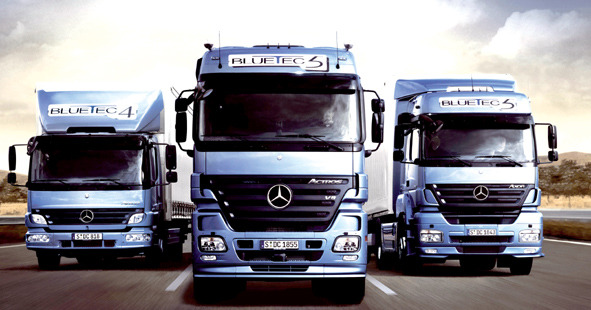 “The jubilee year (125 years) of the automobile was another successful year for Daimler. But we believe we can do even better.” says Dr. Dieter Zetsche, Chairman of the Board of Management, Daimler AG and Head of Mercedes-Benz Cars. We see why and how the year gone-by was a big success for Daimler, as we zero in on the performance of Daimler Trucks and Daimler Buses in 2011.
“The jubilee year (125 years) of the automobile was another successful year for Daimler. But we believe we can do even better.” says Dr. Dieter Zetsche, Chairman of the Board of Management, Daimler AG and Head of Mercedes-Benz Cars. We see why and how the year gone-by was a big success for Daimler, as we zero in on the performance of Daimler Trucks and Daimler Buses in 2011.
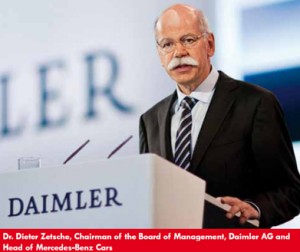 The year 2011 was a very good one for Daimler Trucks. Total unit sales increased by 20 per cent to 425,800 vehicles worldwide, while revenue grew by 20 per cent to Euro 28.8 billion and EBIT rose by a strong 41 per cent to Euro 1.9 billion. “We are updating our product range very successfully in all business units and regions. The best example is the new Mercedes-Benz Actros, which was already named ‘Truck of the Year’ in its year of launch. After the natural disaster in Japan, Fuso quickly returned to its previous level of production, thanks to its employees’ exceptional efforts. And we are boosting efficiency worldwide by intensifying global co-operation between procurement, production and production planning”, adds Dr. Zetsche.
The year 2011 was a very good one for Daimler Trucks. Total unit sales increased by 20 per cent to 425,800 vehicles worldwide, while revenue grew by 20 per cent to Euro 28.8 billion and EBIT rose by a strong 41 per cent to Euro 1.9 billion. “We are updating our product range very successfully in all business units and regions. The best example is the new Mercedes-Benz Actros, which was already named ‘Truck of the Year’ in its year of launch. After the natural disaster in Japan, Fuso quickly returned to its previous level of production, thanks to its employees’ exceptional efforts. And we are boosting efficiency worldwide by intensifying global co-operation between procurement, production and production planning”, adds Dr. Zetsche.
Excellent sales in Europe, Latin America
Trucks Europe/Latin America has global responsibility for all the truck activities of the Daimler Group under the Mercedes-Benz brand. With another strong increase in unit sales to 159,300 vehicles (2010: 135,200), Trucks Europe / Latin America equalled the high level of 2007. A significant contribution came from Western Europe, where Daimler remained the market leader in the medium- and heavy-duty truck segments. In Russia, its unit sales doubled to 3,300 vehicles, thanks to co-ordinated activities with Kamaz.
In Latin America, the company’s unit sales reached a new record of 52,600 vehicles. Despite the tough competition in Brazil, the region’s biggest market, Daimler achieved the high level of the prior year with sales of 44,100 units.
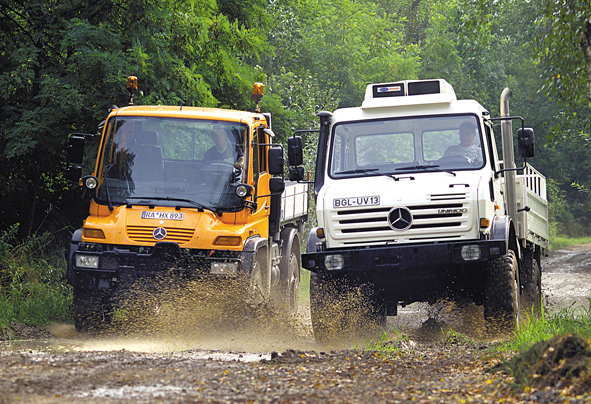 The current Euro III emissions regulations will be replaced by the more stringent Euro V standards in Brazil in 2012 and in Argentina in 2013. In response to these developments, truck manufacturers are upgrading their model ranges. With Daimler’s product line-up, it is well prepared for the change.
The current Euro III emissions regulations will be replaced by the more stringent Euro V standards in Brazil in 2012 and in Argentina in 2013. In response to these developments, truck manufacturers are upgrading their model ranges. With Daimler’s product line-up, it is well prepared for the change.
Trucks Asia expansion
With its Canter, Fighter and Super Great truck models, the Fuso brand has gained a reputation around the world as a quality-focused truck manufacturer whose products range from light-duty models to heavy-duty vehicles. Fuso is also Daimler Trucks’ Center of Excellence for light-duty trucks and cutting-edge hybrid technology. Despite challenges, Fuso managed to sell 147,700 vehicles in 2011, which was actually five per cent more than in the prior year. The Japanese market accounted for 27,000 units, representing an increase of nine per cent.
In Eastern Europe, sales rose by 28 per cent. Another milestone was registered in Russia where 2,000 vehicles were sold in 2011 (2010: 800). Trucks Asia’s unit sales rose significantly also in the NAFTA region, up by a strong 16 per cent to 3,500 vehicles. In another important development, it launched medium-duty Fuso trucks in South Africa in early October.
In RIC countries
Daimler Trucks is also enjoying success in the RIC countries. In Russia, for example, Fuso Kamaz Trucks Rus has been manufacturing Canter vehicles since 2010. The official inauguration of the new Mercedes-Benz Trucks Vostok production line, which manufactures Actros, Axor and Unimog models, followed in early 2011.
The truck plant in Chennai has been completed, and it has begun producing vehicles of the new BharatBenz brand. A major success for Daimler in China last year was its receiving the final approval to establish a joint venture with Foton Motor. With its 50 per cent stake in Beijing Foton Daimler Automotive Co., Ltd., it will further strengthen and expand its position in medium- and heavy-duty trucks segment in the Chinese market.
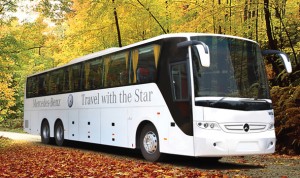 Market outlook
Market outlook
Worldwide demand for medium and heavy trucks in 2012 is expected to be at least at the level of last year. Despite a perceptible slowdown, the North American market should prove to be the world’s most important driver of demand, expanding by 15-20 per cent.
Above all, in the US, the sustained growth in investment and the increasing need for replacements due to the relatively old fleet of vehicles should allow strong growth in demand once again.
However, demand for trucks in Europe will be impacted by the ongoing sovereign-debt crisis and the resulting economic weakness. So, at best, demand in that market can only be expected to be as strong as last year. Market contraction of up to 10 per cent is not impossible from today’s perspective, but Daimler foresees a better development in the second half of the year than in the first. The Japanese market for heavy- and medium-duty trucks should expand once again by 5 to 10% compared with the prior year, thanks to the country’s economic growth, which is benefiting from the reconstruction efforts.
Overall demand for trucks in the emerging markets should grow only moderately this year. In China, new registrations are expected to normalize, after they had already fallen last year with the withdrawal of State incentives for truck buyers. Demand in India is likely to stabilize. The Brazilian market, which is important to Daimler, will probably experience a drop in demand of 10-15 per cent following introduction of more stringent emission regulations (similar to Euro V). In Russia, growth rates should be significantly more moderate than in the past two years.
Buses Division
The Daimler Buses Division with its brands Mercedes-Benz, Setra and Orion, continues to be the world’s leading manufacturer with a large margin in its core markets in the segment of buses and coaches above 8 tons. The product range supplied by Daimler Buses covers city and inter-city buses, coaches and bus chassis. The most important of the 15 production sites are in Germany, France, Spain, Turkey, Argentina, Brazil, Canada, Mexico and the US.
Daimler Buses clearly maintained the leading position in all its key markets, despite weaker market demand for complete buses. The company further increased its unit sales in 2011, defending its leadership in its core markets in the segment of buses over 8 tons. With the presentation of the new Mercedes-Benz Citaro, it is setting new benchmarks in the premium city-bus segment.
In 2011, 43 per cent of Daimler Buses’ revenue was generated in Western Europe, 11 per cent in the NAFTA markets and 29 per cent in Latin America (excluding Mexico). While the company mainly sells complete buses in Europe and the NAFTA region, its business in Latin America, Africa and Asia is focused on production and distribution of bus chassis.
With unit sales of 39,700 complete buses and bus chassis, the company surpassed the prior-year figure by two per cent despite a generally difficult market situation. In its core markets in the segment of buses over 8 tons gross vehicle weight, it was the market leader by a large margin once again in 2011. The factors contributing for the increase in unit sales were the positive business development for Mercedes-Benz bus chassis in Latin America, including Mexico, and significant growth in sales of complete buses in Turkey.
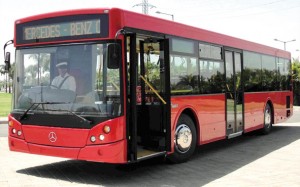 In Western Europe, unit sales decreased by 17 per cent to 5,900 buses. Nonetheless, Daimler Buses succeeded in maintaining its leading position in the region with a market share of 27 per cent (2010: 29.6 per cent). In Latin America, Daimler Buses increased its chassis sales of the Mercedes-Benz brand by 8 per cent to 25,000 units. Its market share in Latin America therefore remained at a high level of 43 per cent (2010: 47.1 per cent). While the Mexican market continued to recover, unit sales decreased in North America.
In Western Europe, unit sales decreased by 17 per cent to 5,900 buses. Nonetheless, Daimler Buses succeeded in maintaining its leading position in the region with a market share of 27 per cent (2010: 29.6 per cent). In Latin America, Daimler Buses increased its chassis sales of the Mercedes-Benz brand by 8 per cent to 25,000 units. Its market share in Latin America therefore remained at a high level of 43 per cent (2010: 47.1 per cent). While the Mexican market continued to recover, unit sales decreased in North America.
City bus launched in India
In March 2012, Daimler Buses launched the first Mercedes-Benz city bus in the Indian market. Following the launch of a two-axle coach in 2008 and a three-axle coach in 2010, the company now aims to establish itself in the country’s city-bus market with its Mercedes-Benz brand. The Indian market already has a high volume of about 50,000 buses per annum and is expected to grow rapidly in the years ahead. India already has the world’s largest bus market after China.
For 125 years, Daimler has pioneered innovation and engineering in the field of automobiles. The company still remains a global leader and continues to come up with path-breaking innovations and technologies for the development of the automotive industry. With expanding presence across the globe, the inventors of the first automobile would certainly be keen on treading new paths for others to follow and customers to cherish.